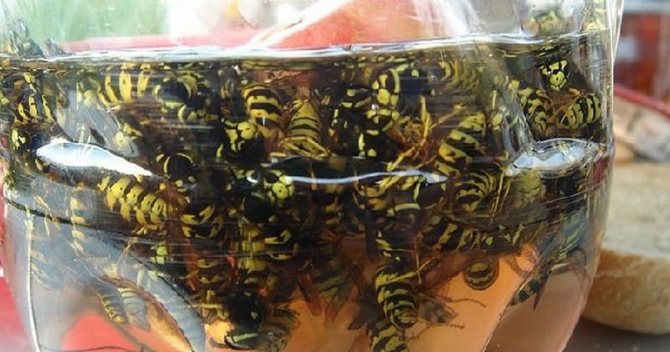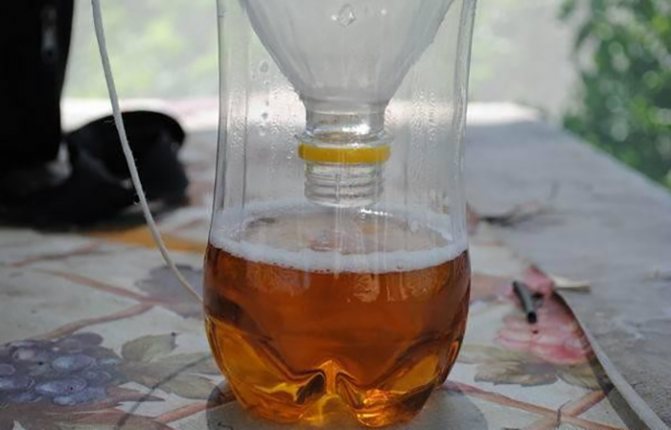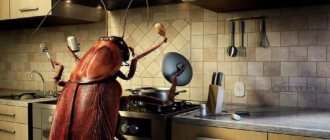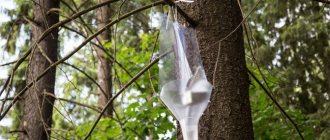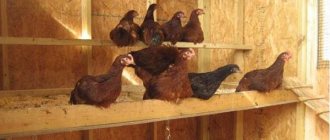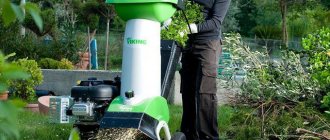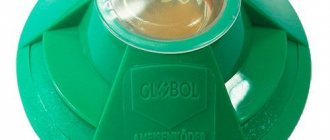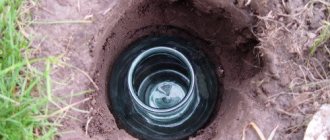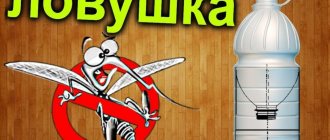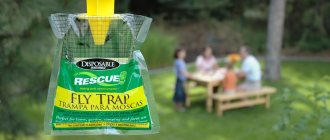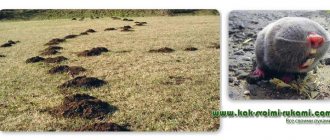Wasps are controversial insects. On the one hand, they bring clear benefits, destroying pests in the garden area. On the other hand, this is not the best neighborhood for a person. Aggressive, they bite painfully and have a very toxic poison. There are many ways to protect yourself from meeting them. One of the most effective and safe is the wasp trap from a plastic bottle. It is easy to make it yourself, thereby protecting your yard from uninvited guests.
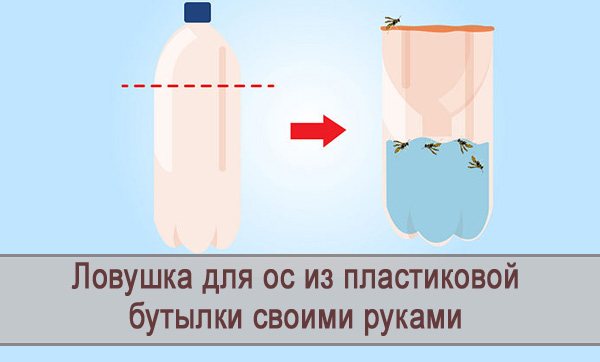
Wasp trap from a plastic bottle
The most common design of the available tools. You can make a wasp trap at home in a few minutes.
You will need:
- a bottle with a capacity of at least 1.5 liters of lemonade, beer, kvass, mineral water;
- scotch tape or stapler with staples, electrical tape;
- scissors;
- lace or screws.
The manufacturing process is extremely simple and does not require any special skills.
- Cut off the neck.
- Turn upside down, insert back into the bottle.
- Fix with tape or staples.
- Cut holes on the sides, insert a lace so that you can hang. Or screw in the selected location.
A do-it-yourself wasp trap is ready. It remains only to put the bait on the bottom.
On a note!
A bottle with a volume of more than 2 liters will be the optimal container for the manufacture of a structure. Wasps give signals to each other about finding food. In a few minutes, almost the entire swarm will fly off. Several dozen individuals gather in the bottle per day.
Periodically, the trap should be emptied, filled with new bait, so it is more convenient to fix the neck with adhesive tape, tape. It is easy to tear it off, stick a new tape in place.
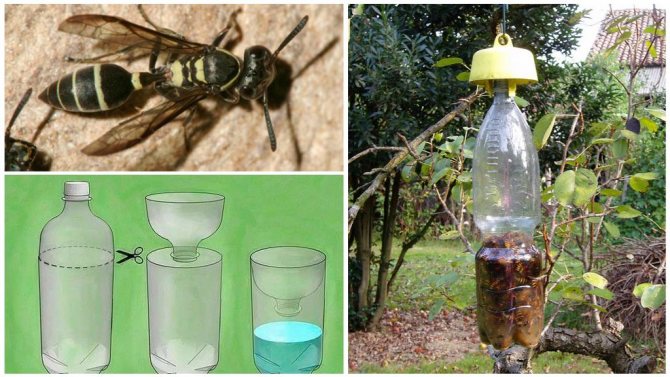

Wasp trap from a plastic bottle
The principle of operation is simple. The wasp flies to the aroma of the bait, crawls into the neck, feasts on its fill, tries to get out. However, a transparent bottle prevents the insect from finding a way out. The wasp either crawls up the wall, or takes off, but remains inside.
The advantages and effectiveness of homemade designs
The main advantages of the solution are the following factors:
- cheapness, since only improvised materials are needed for their implementation, in most cases they are reduced to used plastic containers, bottles;
- the ability to cover any areas - traps made literally from garbage are distributed in the right amount across the territory;
- unpretentious maintenance, expressed in the disposal of pests and the introduction of new bait;
- environmental friendliness - the absence of poisonous drugs in the composition;
- non-volatility due to the extreme simplicity of the design.
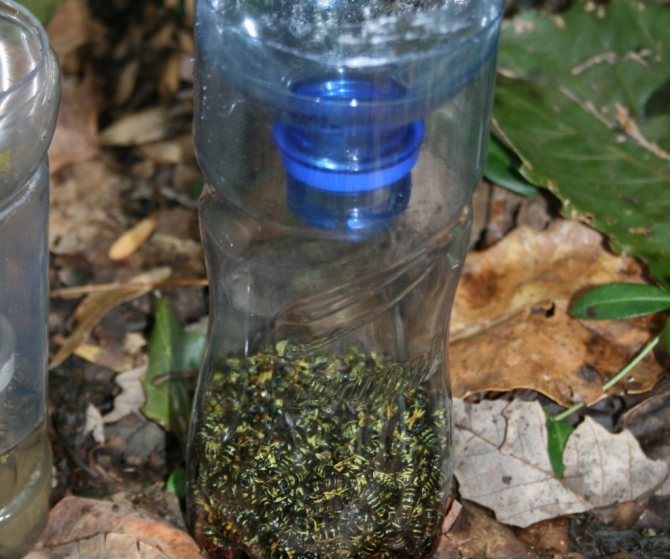

The DIY wasp trap is cheap and unpretentious.
Such home-made modifications are not able to completely get rid of dangerous wasps, but they help to temporarily protect households and pets from annoying neighborhoods. The only thing you should be prepared for is the need to get rid of the unpleasant mass accumulating inside the device.
Simple, effective trap
If you don't have the time or desire to build a structure for insects, you can make a wasp trap at home in a matter of minutes. The principle of action is to lure insects, force them to get into a trap. Water is poured into the container, covered with foil with holes, put in the right place.The best option is a glass jar from 0.5 l to 3 l.
Do not wash the jam jar, fill it halfway with water, cover with foil, make holes. Wasps will flock to the aroma, start to make their way to the food through the holes, and immediately drown.
You do not need to cover the container with anything, but add a little detergent or liquid soap to the water. Effective bait - Coca-Cola, sugar, water, beer. You can just leave a little drink at the bottom of the bottle, cut off the neck, grease the walls with petroleum jelly or vegetable oil.
Use a twist-top jar to make the trap. The bait is poured inside, holes are made in the lid. A photo of the wasp trap is presented below.


Wasp traps
What to do if bitten by a wasp
To make soda lotions - dissolve 1 teaspoon of soda in half a glass of water, moisten a cotton swab and apply to the wound; take an antiallergic drug (suprastin, diphenhydramine, diazolin, etc.), and with a very strong reaction - the hormonal drug hydrocortisone or dexamethasone intramuscularly.
Some recommend rubbing the wound with garlic, onions or parsley immediately after the sting - this should relieve the swelling; you can apply a cotton swab with ammonia diluted with water 1: 5.
If a bitten person develops swelling of facial tissues, bronchospasm, frequent heartbeats, cramps, pain in the lower back, joints, heart area - without wasting a second, call an ambulance.
What methods of dealing with wasps do you know, dear reader? How to reduce the pain of a wasp sting? What situations have happened in your life? Let us know in the comments below this article!
The right bait
To lure an insect into a trap, it must be attracted by scent. Wasp bait can be sweet, sour, liquid, hard. Adults feed on plant juices, liquid, honey, but they get protein food for their larvae. Sugar and meat will be equally effective.
Do-it-yourself wasp bait is very simple. You need to choose the ingredients, place them in the trap. Update periodically. To attract insects, use:
- Apple juice;
- honey;
- jam;
- lemonade;
- kvass;
- beer;
- Coca Cola;
- crushed grapes, other berries;
- lemon juice;
- sugar, syrup;
- apple, wine, table vinegar with sugar;
- compote;
- pieces of ripe fruit;
- meat;
- a fish.
It is recommended to use meat bait to catch wasps in spring, early summer. At the end of April, the uterus looks for a place to build a nest, and also looks for food for the larvae. If it can be caught, there will be no wasp swarm on the site. In other cases, the larvae will simply be left without food. To prevent the bait from drying out, add a little water to the bottom of the bottle. Pork, beef, chicken is not suitable for these purposes. It is not at all necessary to use a fresh product; rotten meat lures insects even more.


Wasp baits
On a note!
A homemade wasp trap is often placed in an apiary around the perimeter of the site or near the hive. So that the bees do not fall into the trap, they pour inside the bait, which is of no interest to them. Bees are indifferent to mash, beer, fish, meat. Pouring sweets, juices, throwing pieces of fruit is not recommended.
A little about wasps
Wasps are not evil by nature, even useful, as they pollinate flowers, trees, and other plants. They become aggressive among people, and in some cases even use poison against them. It happens that a person bitten by a wasp is forced to consult a doctor. Therefore, it is recommended to install wasp traps in every garden and vegetable garden.
A large number of insects in a garden means that there is a swarm of insects nearby.
Wasps love to make their nests on horizontal surfaces. Under the eaves, on the roof, or under a bench.If their number is large, they become aggressive, so place wasp traps in the immediate vicinity of strawberry beds, grape bushes, and other food. A wasp trap helps to effectively keep the wasp population in your garden under control. Remember to set the trap away from home.
Simple DIY trap
To prepare a natural trap you need:
- 1 cup of sugar.
- 4 tablespoons of salt.
- 4 tablespoons of sugar.
- 1 tablespoon vinegar (so as not to attract bees and bumblebees).
- Plastic bottles.
With a sharp knife around the perimeter, cut off 1/3 of the plastic bottle from the side of the neck. Turn it upside down and insert with the neck down into the rest of the bottle. Pour the solution and place in the place where the swarm of wasps is located.
Wasp trap can be filled with any sweet liquid
Sticky Wasp Trap
If the wasp family settled near the house, in the wall, outbuildings, periodically fly into the house, you can catch them with the help of sticky tape for flies. They are hung on the windows, near the door.
In the apiary, in the garden, in the yard, they use a homemade sticky wasp trap. You can make it in 5 minutes. For manufacturing, you need a base - a piece of plywood, oilcloth, plastic, wood or other durable material on which you can apply glue.
They buy a special non-drying glue, which is used to catch cockroaches in the ants' garden. Suitable remedy - Clean House, Viola, RaTrap. Apply to the surface with a minimum distance between the stripes. It takes about 120 g of glue to make one trap. The finished structure is suspended from a tree, a wall, or any suitable place.
On a note!
The main disadvantage is that not only wasps, but also other insects can fall into the trap. In rainy weather, the trap quickly loses its properties.


Insect glue trap
How to reduce the number of wasps on the site?
Traps and sticky tape come to the rescue! Each of these methods has advantages. It is necessary to consider each method of dealing with flying gluttons separately.
Ribbon and its efficiency
One of the easiest ways. What should be done?
- Buy special insect tape from the store. It is desirable that it has not only a high adhesive ability, but also poison the shrunken insects.
- Inspect the site and find a nest.
- Hang the tape near the insect dwelling.
- If there is no nest on the site, then sticky strips should be hung in places where insects accumulate: raspberries, fruit trees, vineyards.
The disadvantage of this method is the rapid deterioration of the tape. It needs to be changed every day. On the other hand, it is inexpensive and easy to hang.


DIY adhesive strips
In order to make an adhesive tape from insects with your own hands, you will need only 2 components:
- Scotch;
- insect glue.
The process of creating a feed consists of several steps.
- Unwind 70-100 cm of scotch tape.
- Fasten a weight on one side. For example, a medium sized nut.
- Apply insect glue to the sticky side of the unwound tape.
- Fasten the strips in places where insects accumulate.
Such a product is capable of trapping flies, bees, small wasps and other insects. Large individuals and hornets have strong wings and in some cases are picked out of the glue. To make the sticky tape more effective, small pieces of crushed fruit are placed on its surface. To increase the effectiveness of the product, a wide adhesive tape is used. The glue should not have toxic chemical odors, otherwise it will scare off wasps.
Attention! Insect glue can be poisonous! It is necessary to carry out preparatory work with gloves, and after all procedures, hands should be thoroughly washed.
Poison trap
If there is no time to prepare the structure, but you need to get rid of the wasps, you can use any fruit or poison.The easiest way to kill annoying insects. Watermelon, melon, grapes, ripe apple, aromatic pear are suitable as bait. Cut in half so that insects can easily access the juice.
The poison is used odorless so as not to scare off pests. Any dust is suitable, powder - boric acid, Clean House, as well as liquid products Lambda Zone, Delta Zone. It remains only to choose a suitable place, to leave the bait. A photo of such a trap can be seen below.
If catching pests does not save the situation, you need to start looking for a nest on the land, dacha and get rid of it.
How does the trap work and when is it needed?
The classic trap attracts the attention of wasps flying nearby with an appetizing bait. Getting into it, the individual is immobilized due to the sticky composition. To speed up its death, poisonous wasp baits containing insecticides are sometimes poured into the product, but the insect can feel the presence of toxic substances and fly by.
All traps can be conventionally grouped into 4 groups:
- Simple flat surface wasp traps.
- A container with holes cut in it.
- Containers with funnels through which the victim gets inside.
- Technical devices (for example, attracting insects with light).
A wasp trap in nature will significantly reduce the number of insects flying in the area, distracting them from humans. This will allow you to spend your time comfortably. Some products can also be used in the home to protect yourself from wasp stings, which can cause painful skin reactions.
Pros and cons
No insect control method is perfect. Each of them has its own objective advantages and disadvantages.
Pros:
- Safety. Most of the structures have a simple structure, and their operation does not require the use of toxic substances.
- Environmental friendliness.
- Versatility. Traps can be used both indoors and in any corner of the local area.
- Reusable.
- Cheapness. Making homemade products requires minimal costs.
But there are also disadvantages, which are also worth mentioning:
- Insects cannot be driven away once and for all. They will be back soon.
- The trap must be cleaned or replaced every day.
- It is necessary to prepare an attractive bait.
A trap is a primitive way to fight insects. Despite the disadvantages and not the duration of the effect, it is easy to use, and can significantly reduce the number of wasps in and around the house.


